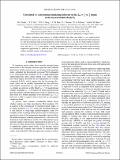Files in this item
Correlated vs. conventional insulating behavior in the Jeff = ½ vs. ¾ bands in the layered iridate Ba2IrO4
Item metadata
| dc.contributor.author | Uchida, M. | |
| dc.contributor.author | Nie, Y. F. | |
| dc.contributor.author | King, P. D. C. | |
| dc.contributor.author | Kim, C. H. | |
| dc.contributor.author | Fennie, C. J. | |
| dc.contributor.author | Schlom, D. G. | |
| dc.contributor.author | Shen, K. M. | |
| dc.date.accessioned | 2015-03-27T11:01:03Z | |
| dc.date.available | 2015-03-27T11:01:03Z | |
| dc.date.issued | 2014-08-25 | |
| dc.identifier | 155249707 | |
| dc.identifier | 999341fb-4978-4da5-ad03-e1e2d965f129 | |
| dc.identifier | 000341263400001 | |
| dc.identifier | 84929113644 | |
| dc.identifier.citation | Uchida , M , Nie , Y F , King , P D C , Kim , C H , Fennie , C J , Schlom , D G & Shen , K M 2014 , ' Correlated vs. conventional insulating behavior in the J eff = ½ vs. ¾ bands in the layered iridate Ba 2 IrO 4 ' , Physical Review. B, Condensed matter and materials physics , vol. 90 , no. 7 , 075142 . https://doi.org/10.1103/PhysRevB.90.075142 | en |
| dc.identifier.issn | 1098-0121 | |
| dc.identifier.uri | https://hdl.handle.net/10023/6379 | |
| dc.description.abstract | We employ molecular beam epitaxy to stabilize Ba2IrO4 thin films and utilize in situ angle-resolved photoemission spectroscopy to investigate the evolution of its electronic structure through the Neel temperature T-N. Our measurements indicate that dispersions of the relativistic Jeff = ½ vs. ¾ bands exhibit an unusual dichotomy in their behavior through the Neel transition. Although the charge gap survives into the paramagnetic state, only the Jeff = ½ state exhibits a strong temperature dependence and its gap softens with increasing temperature approaching T-N, while the nearly fully occupied Jeff = ¾ state which remains nearby in energy exhibits negligible changes with temperature. | |
| dc.format.extent | 6 | |
| dc.format.extent | 2594558 | |
| dc.language.iso | eng | |
| dc.relation.ispartof | Physical Review. B, Condensed matter and materials physics | en |
| dc.subject | SR2IRO4 | en |
| dc.subject | QC Physics | en |
| dc.subject.lcc | QC | en |
| dc.title | Correlated vs. conventional insulating behavior in the Jeff = ½ vs. ¾ bands in the layered iridate Ba2IrO4 | en |
| dc.type | Journal article | en |
| dc.contributor.institution | University of St Andrews. School of Physics and Astronomy | en |
| dc.contributor.institution | University of St Andrews. Condensed Matter Physics | en |
| dc.identifier.doi | https://doi.org/10.1103/PhysRevB.90.075142 | |
| dc.description.status | Peer reviewed | en |
| dc.identifier.url | http://journals.aps.org/prb/supplemental/10.1103/PhysRevB.90.075142 | en |
This item appears in the following Collection(s)
Items in the St Andrews Research Repository are protected by copyright, with all rights reserved, unless otherwise indicated.

